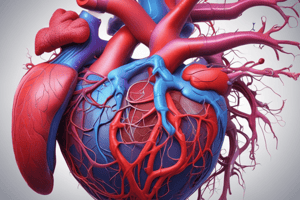Podcast
Questions and Answers
Which structures drain into the right atrium?
Which structures drain into the right atrium?
- Veins from the lungs
- Superior and inferior vena cavae, coronary sinus (correct)
- Right and left coronary arteries
- Pulmonary veins
What is one characteristic of the left atrium?
What is one characteristic of the left atrium?
- Has a Tebesian valve
- Drains into the right ventricle
- Receives pulmonary veins (correct)
- Contains pectineal muscles
Which of the following statements about the atrioventricular valves is false?
Which of the following statements about the atrioventricular valves is false?
- They are located between atria and ventricles.
- They have no chordae tendinae. (correct)
- They consist of tricuspid and mitral valves.
- They prevent backflow of blood into the atria.
What is the main difference between the right and left coronary arteries?
What is the main difference between the right and left coronary arteries?
Which structure is located between the right and left ventricles?
Which structure is located between the right and left ventricles?
Flashcards
Pericardium
Pericardium
A double-layered sac that surrounds the heart, protecting it and keeping it in place. It has a tough outer layer (fibrous pericardium) and a delicate inner layer (serous pericardium).
Interventricular Septum
Interventricular Septum
The wall that separates the two ventricles of the heart, ensuring blood flow is directed correctly.
Tricuspid Valve
Tricuspid Valve
The right atrioventricular valve, also known as the tricuspid valve, controls blood flow between the right atrium and right ventricle. It has three flaps (cuspids) that open and close to regulate the flow.
Mitral Valve
Mitral Valve
Signup and view all the flashcards
Aorta
Aorta
Signup and view all the flashcards
Study Notes
Heart External Configuration
- The pericardium surrounds the heart.
- The fibrous pericardium is the outer layer.
- The serous pericardium has two layers: a parietal layer and a visceral layer.
- The visceral layer is also known as the epicardium.
Heart Internal Configuration
- The heart has four chambers: two atria and two ventricles.
- There are two types of heart valves: atrioventricular and semilunar.
- The atrioventricular valves are the tricuspid and mitral valves.
- The semilunar valves are the pulmonary and aortic valves.
- The interventricular septum separates the ventricles.
Characteristics of the Right Atrium
- The right atrium receives deoxygenated blood from the body.
- This blood flows through the superior and inferior vena cava and coronary sinus.
- Structures like the fossa ovalis, pectinate muscles, and the right atrial auricle are present.
Characteristics of the Left Atrium
- The left atrium receives oxygenated blood from the lungs via the pulmonary veins.
Characteristics of the Right Ventricle
- The right ventricle pumps deoxygenated blood to the lungs.
Characteristics of the Left Ventricle
- The left ventricle pumps oxygenated blood to the body.
- The left ventricle possesses a thicker wall due to its greater workload.
Atrioventricular Valves
- The structure includes cusps, chordae tendineae, and papillary muscles.
- The function of the valves is to prevent backflow of blood into the atria during ventricular contraction.
Semilunar Valves
- These valves consist of three cusps each and prevent backflow into the ventricles during diastole (relaxation).
Cardiac Vascularization
- Coronary arteries supply blood to the heart muscle.
- The right and left coronary arteries branch to supply specific heart regions.
Studying That Suits You
Use AI to generate personalized quizzes and flashcards to suit your learning preferences.




